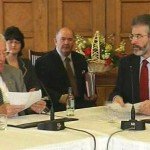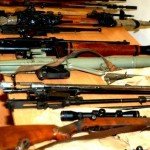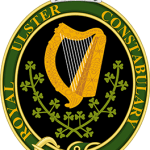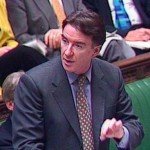
On December 2nd 1999 the British government devolved power to the Northern Ireland Assembly and Executive. Northern Ireland now had self government, a Unionist First Minister (David Trimble) and a Nationalist Deputy First Minister (Seamus Mallon). Its ten-person ministry contained representatives of the four major parties. Its Assembly was settled and the first meeting of the North-South Ministerial Council was scheduled for mid-December. The power-sharing government envisioned in the Good Friday Agreement appeared to have taken shape. Several issues would hinder the success of this arrangement – but by far the largest stumbling block was the decommissioning of paramilitary weapons. Unionists refused to work with Sinn Fein until the Irish Republican Army (IRA) had set about disarming. Sinn Fein argued that it was a separate entity from the Provisional IRA and exerted no control over it. The Provisional IRA reminded Unionists that it was not a signatory to Good Friday so had, in fact, agreed to nothing. These disputes evolved into a political crisis that led Westminster to suspend the Northern Ireland government and reimpose Direct Rule, first in February 2000 and again twice briefly in 2001.
Disputes over decommissioning
The Good Friday Agreement named May 22nd 2000, two years after the joint referendum, as the deadline for full decommissioning. Responsibility for overseeing paramilitary disarmament was handed to the Independent International Commission on Decommissioning (IICD), headed by Canadian general John de Chastelain. Progress was slow, however, and decommissioning remained a sticking point between the Unionists and Sinn Fein. Several incidents during 1999 highlighted the urgent need for a reduction in weapons. In March 1999 Rosemary Nelson, a human rights lawyer who had represented Catholics from the Garvaghy Road area, was assassinated by a car bomb. A Loyalist paramilitary group, the Red Hand Defenders, claimed responsibility for Nelson’s murder, while Nationalists alleged involvement by security forces. In the same month, the Provisional IRA admitted murdering and disposing of several individuals during the 1970s and 1980s. These ‘Disappeared’, as they had become known, were suspected of providing information to British security forces.

These developments, along with more killings and sectarian violence through 1999, intensified calls for decommissioning. Emerging evidence raised doubts about how committed some groups were to the process. In August 1999 the United States Federal Bureau of Investigation (FBI) reported breaking up a Provisional IRA arms smuggling operation; four people were arrested after dozens of handguns and machine pistols were smuggled out of Florida and back to Northern Ireland. The IRA leadership disavowed any knowledge of this, claiming the weapons had been acquired by dissidents. Loyalists and Unionists seized on the news, however, claiming it as evidence of Republican dishonesty. Democratic Unionist Party (DUP) leader Ian Paisley told the Northern Ireland Assembly it was his “firm conviction that the IRA has no intention of decommissioning… Unionist people are sick of being misled and lied to over the issue of decommissioning. Even the ‘Yes’ voters must be embarrassed by their misplaced political judgement in putting their trust in the word of the IRA.”
“Sinn Fein is not the IRA”

The Republican position on decommissioning was more complex. Leading Republicans were infuriated that decommissioning had become a prerequisite for Sinn Fein’s participation in government, a condition not factored into the Good Friday Agreement. Gerry Adams maintained throughout the dispute that Sinn Fein was separate from the Provisional IRA: it wielded no control over the Provos and could not force them to disarm. Any steps towards decommissioning, Adams argued, must be taken by the leaders of the IRA. This was not as easy as it might seem, given the group’s decentralisation and internal politics. A command decision to destroy weapons and submit to IICD inspections would be seen by many IRA volunteers as an act of surrender. To do this risked an internal coup, an exodus of members to the Real IRA or the formation of new dissident groups. Any move toward decommissioning would, therefore, need to be carefully managed. Many Republicans were also opposed to disarmament while violent Loyalists remained active and while the British maintained 13,500 soldiers in Northern Ireland.

Unionists were also riled by a report from another independent commission, tasked with inquiring into and overhauling policing in Northern Ireland. Chris Patten’s September 1999 report contained 175 recommendations for building a police force that was more effective, less provocative and able to win the trust of local communities. Patten’s most significant recommendation was renaming the Royal Ulster Constabulary (RUC) the Police Service of Northern Ireland (PSNI) and stripping it of British-Loyalist symbols. The Patten report also suggested a recruiting policy that would correct the imbalance in Protestant and Catholic officers in Northern Ireland policing. Loyalists were outraged, one calling the name change “an insult to the memory of RUC officers who gave their lives in defence of this community”. Trimble called the Patten report “the most shoddy piece of work I have seen”. Ian Paisley claimed Patten’s reforms constituted “ethnic cleansing” and “deliberate discrimination against Protestants”. British and Nationalist politicians welcomed Patten’s report, Tony Blair calling it “a good and thorough piece of work”.
The return of Direct Rule

The issue of decommissioning came to a head shortly after devolution. In December 1999 de Chastelain and other IICD delegates held meetings with the IRA and Loyalist paramilitary groups. All promised de Chastelain they would begin disarming the following month. The first weeks of 2000 produced no evidence of arms decommissioning. On January 31st General de Chastelain reported that while paramilitary groups remained committed to decommissioning, there was no “further evidence” that decommissioning had actually commenced. He also reported that it would be impossible for these groups to fully decommission by the May 22nd deadline. Relations within the Executive became tense and difficult, the Unionists demanding progress on decommissioning and both Sinn Fein and the Provisional IRA refusing to make promises. On February 11th, after 72 days of devolution, Northern Ireland Secretary of State Peter Mandelson suspended the Northern Ireland Assembly and reimposed Direct Rule. “I regret very much having to do this,” Mandelson said, “but we have got to clear up this issue of decommissioning once and for all. It has dogged the process throughout, and it has sapped confidence in the institutions.”
Mandelson, along with Tony Blair and members of the Irish government, spent the next three months trying to resolve the issues. A breakthrough came in early May 2000, when Provisional IRA representatives promised to put its weapons “completely and verifiably beyond use” and to allow IICD inspectors into its arms dumps. This was welcomed by David Trimble and the Ulster Unionist Party (UUP), clearing the way for devolution to be restored on May 30th. The deadline for full decommissioning was extended to June 2001, while 500 British soldiers were withdrawn from Northern Ireland. Despite this political progress, sporadic violence continued through the summer of 2000. Two men were shot dead by paramilitary volunteers in late May; both were probably the victims of internecine feuding. The July marching season produced more protests and violence in Portadown after Loyalists were again banned from parading down Garvaghy Road.
Tensions continue
“The decommissioning of paramilitary weapons has been one of – and at times the most – critical and controversial issues in the Northern Ireland peace process. This is hardly surprising. The issue concerns not only weapons responsible for death and destruction but political trust. Illegal weapons in Northern Ireland are as much a symptom as a cause of tension. Even the use of the term ‘decommissioning’ reflects political sensitivities. For Republicans ‘disarmament’ smacks of surrender… while for Unionists ‘demilitarisation’ implies acceptance of the Republican agenda of ‘troops out’.”
Colin McInnes, historian
The decommissioning crisis continued into mid-2001 and beyond. UUP members were outraged at the lack of progress on IRA disarmament and applied pressure to First Minister David Trimble. On October 28th 2000 Trimble took action, banning Sinn Fein members from meetings of the North-South Ministerial Council. Furious Sinn Fein leaders protested this ban in the British High Court, which ruled the ban unlawful. In early May Trimble threatened to resign on July 1st unless there was clear evidence the IRA had begun to decommission. Trimble followed through on his threat after the IICD produced another hollow report. Talks continued through August, while the Real IRA and other dissident paramilitary groups carried out sporadic attacks in the background. A breakthrough came two months later, in the wake of the devastating September 11th terrorist attacks on the United States. On October 22nd Gerry Adams delivered a significant speech, asking Provisional IRA members to accept decommissioning in order to save the peace process. The following day the IRA announced its intention to comply with the IICD and begin decommissioning.

1. The Good Friday Agreement called on paramilitary groups to decommission their weapons and munitions, fixing a deadline of May 22nd 2000, two years after the joint referendum.
2. This deadline was not met, however, and disputes over decommissioning continued to plague the new power-sharing government until October 2001.
3. Unionists refused to share government with Sinn Fein until there was substantial evidence that the Provisional IRA had commenced decommissioning.
4. The IRA was reluctant to decommission for internal political reasons – and because the British military still had 13,500 troops stationed in Northern Ireland.
5. The decommissioning crisis led to Direct Rule being reintroduced in February 2000. The Provisional IRA eventually began the process of decommissioning in October 2001.

General de Chastelain seeks information from parties on decommissioning (1999)
Patten Commission’s recommendations for policing reform in Northern Ireland (1999)
General de Chastelain’s report on the progress of decommissioning (2000)
Gerry Adams calls on the Provisional IRA to decommission (2001)
The Provisional IRA announces arms decommissioning (2001)
© Alpha History 2017. Content on this page may not be republished or distributed without permission. For more information please refer to our Terms of Use.
This page was written by Rebekah Poole and Steve Thompson. To reference this page, use the following citation:
R. Poole and S. Thompson, “The decommissioning crisis”, Alpha History, accessed [today’s date], https://alphahistory.com/northernireland/decommissioning-crisis/.
